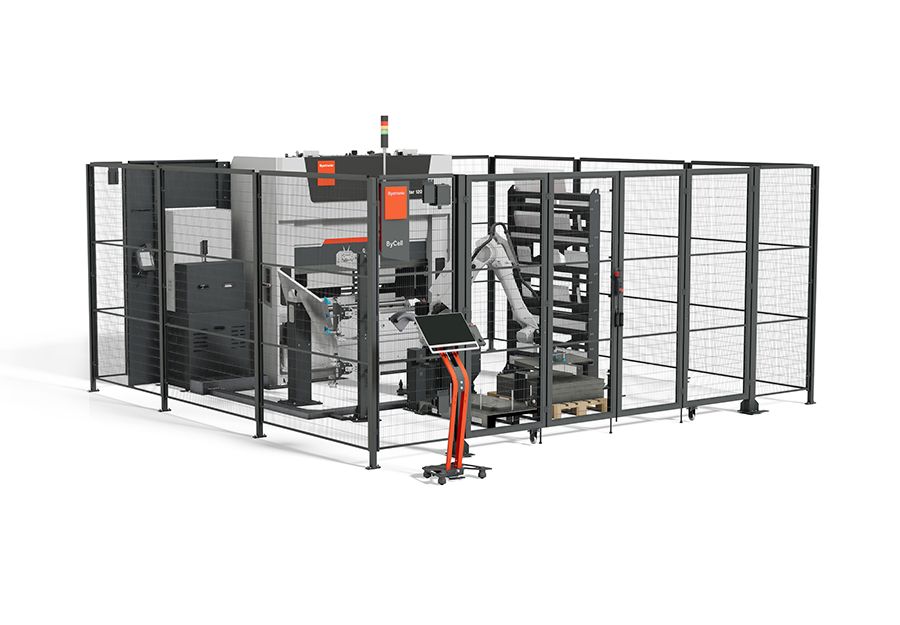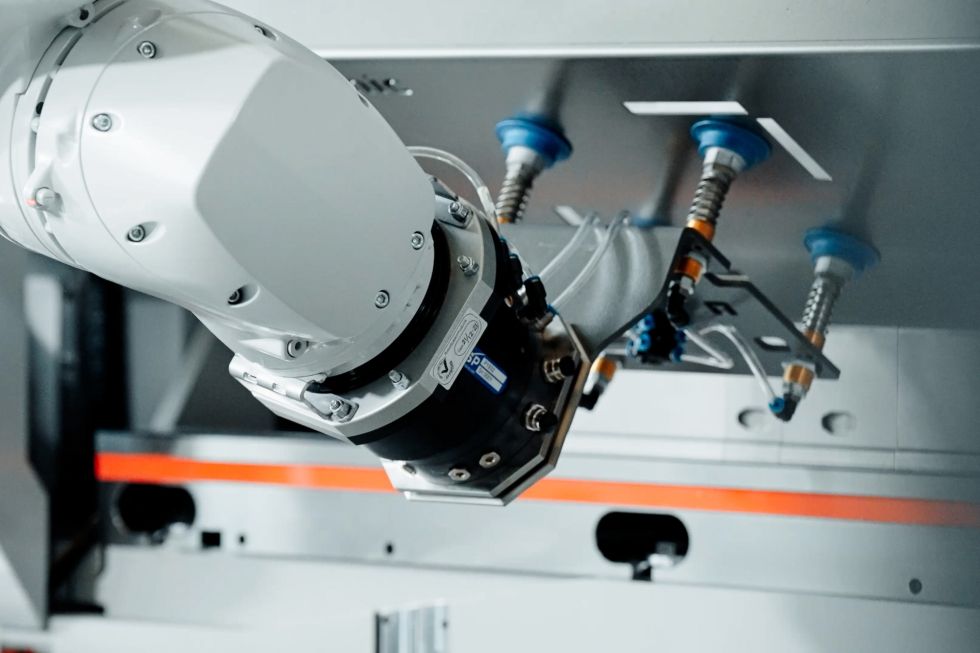
Blog The Role of Automation in Modern Press Brake Operations
Automation is reshaping the way bending departments operate.
What began as simple backgauge control and programmable crowning has evolved into fully integrated systems that combine robotics, intelligent software, and connected data environments.
Today, the goal of press brake automation is not to replace the operator, but to multiply the impact of skilled labor. A well-designed system can allow one operator to manage several cells or oversee both manual and automated bending simultaneously. For shops facing higher throughput demands, tight tolerances, and increasing cost pressures, this approach enables significant gains in efficiency and consistency.
Increasing Output per Operator
In many fabrication facilities, bending remains a bottleneck. Manual handling of heavy blanks, long setup times, and variability between operators all limit productivity.
Automation directly addresses these issues by transferring repetitive, high-precision motions to robotic systems. Material feeding, part orientation, and unloading can all be automated, allowing the operator to focus on quality verification, programming, and scheduling.
In practical use, an operator working alongside automation can produce the output of two or three manual stations. This does not eliminate the need for skilled operators; instead, it allows their expertise to extend across multiple systems.
Consistency, Precision, and Safety
Automated bending systems maintain a constant level of accuracy and repeatability, regardless of shift length or material variation. Robots handle materials the same way every cycle, resulting in uniform bend angles and consistent edge alignment.
Automation also enhances workplace safety. Robots perform all tasks near the pinch point, reducing operator exposure to potential hazards. Systems are enclosed with interlocked safety fences, light curtains, and safe zones that halt all movement if entered. In Bystronic cells, the fence distance is engineered to prevent a dropped sheet from leaving the enclosure, protecting both operators and nearby equipment.
This level of control makes it possible to run production during off-shifts or lights-out periods without compromising safety or quality.
Reducing Setup Time and Changeover
Setup and changeover have traditionally been two of the largest sources of downtime in bending. Automated systems minimize this through automatic tool changers, gripper exchange systems, and offline programming.
The tool changer retrieves punches and dies from storage and installs them automatically according to the digital program. This eliminates manual handling and ensures consistent setups across shifts. A gripper tree allows the robot to switch end effectors automatically for different part geometries or materials.
When combined with offline programming software such as BySoft CAM and Robot Manager, operators can prepare new jobs while the system is still running. Changeovers that once required hours can now be completed in minutes.
Software as the Core of Automation
Software integration is what connects the design, cutting, and bending stages of production. It ensures that every bend, angle, and sequence is digitally verified before the first part is run.
Bystronic’s workflow begins in BySoft CAM, where engineers create bending sequences, assign tools, and validate programs through collision simulation. The same data is then transferred to the cutting stage, ensuring that flat blanks match the bending process. Finally, the data moves into the robot software, which defines how the robot grips, positions, and stacks each part.
This closed data loop eliminates redundant programming, reduces human error, and shortens lead times. For engineers managing high-mix production, it provides complete traceability and version control from CAD file to finished component.
Flexible Hardware Configurations
Automation is not limited to high-volume manufacturing. Scalable systems now make it practical for small and midsize shops to implement robotic bending.
Bystronic, for example, offers automation configurations ranging from compact mobile bending cells to large, fully enclosed production systems. Our innovative midsize bending cell, with 132 tons of force and an 80-inch bending length in a 20 × 21 ft footprint, serves as an efficient mid-range solution.
Modular hardware options, such as pallet systems, rotary tables, and tool racks, allow each shop to configure the system around its space and workflow. This flexibility supports both one-off production and extended unattended runs.
Integration and Material Flow
Efficient material movement is critical to realizing the benefits of automation. Planning how blanks enter and finished parts exit the cell determines overall system productivity.
Bystronic engineers frequently work with customers to define pallet layouts and part flow before installation. Single-in/single-out configurations are ideal for high-mix work, while multi-pallet setups enable extended lights-out production. Attention to material logistics also improves ergonomics by reducing manual lifting and repositioning outside the cell.
Measuring ROI and Performance
Most bending automation investments achieve a return on investment within two years, depending on part mix and utilization.
To validate this, Bystronic conducts feasibility studies using the customer’s actual parts. The parts are programmed, simulated, and run through a live system to confirm cycle times, handling feasibility, and tool requirements. This data provides an accurate basis for ROI calculations.
When evaluating payback, include not only reduced labor and setup time but also gains from increased uptime, consistent part quality, and extended unattended production
Implementation Best Practices
Successful adoption of bending automation depends on preparation and operator engagement. Key steps include:
- Start with automation-suitable parts. Choose components that fit within the robot’s reach and weight capacity.
- Train for both hardware and software. Operators should understand how to adjust bend programs, manage tool changes, and troubleshoot minor issues.
- Plan the layout early. Safety zones, pallet paths, and inspection stations should be incorporated into the facility layout before installation.
- Validate the workflow. Run pilot jobs through simulation and live testing to confirm efficiency and cycle time.
- Maintain operator expertise. Experienced personnel remain essential for verifying results and optimizing parameters.
Automation works best when paired with skilled human oversight.
Preparing for the Next Phase of Smart Fabrication
Press brake automation is becoming a foundational element of the smart factory. Integrated cutting, bending, and logistics systems are now connected through shared data and IoT networks.
Upcoming developments will further expand these capabilities through:
- Adaptive grippers and sensors that adjust automatically to material variations
- Real-time machine data for predictive maintenance
- Faster commissioning through standardized software interfaces
- Modular designs that scale with production requirements
These advancements will continue to shorten lead times, reduce manual input, and increase production flexibility.
Conclusion
Automation in press brake operations allows manufacturers to increase throughput, improve safety, and maintain consistent quality without expanding headcount. One skilled operator can now manage multiple cells, oversee programming, and ensure accuracy across an entire shift.
By combining intelligent software, robotics, and data connectivity, automated bending transforms the press brake from a manual workstation into a high-efficiency production system.
